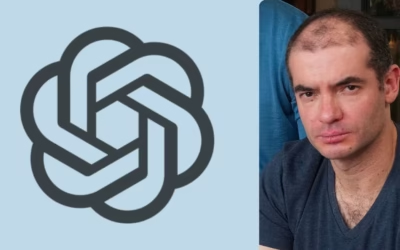David Keith is seeking to implement large-scale interventions on the planet, called “geoengineering,” to combat climate change. Scientists and environmentalists criticize him.
David Keith leads the Climate Systems Engineering Initiative at the University of Chicago.
David Keith was doing graduate studies in 1991 when a volcano erupted in the Philippines and sent a cloud of ash to the edge of space.
The sulfur dioxide expelled by Mount Pinatubo spread through the stratosphere and reflected some of the solar energy back into space. As a result, average temperatures in the Northern Hemisphere dropped by about 0.5 degrees Celsius the following year.
Today, Keith cites this event to validate an idea that has become the focus of his life’s work: he believes it would be possible to lower the global temperature by intentionally releasing sulfur dioxide into the stratosphere.
Such radical interventions are being taken more seriously now as the effects of climate change intensify. Global temperatures have reached record highs for 13 consecutive months. Scientists expect the heat to continue rising for decades. The main driver of warming, the burning of fossil fuels, continues almost unabated.
In this context, there is increasing interest in projects aimed at intentionally altering Earth’s climate, a discipline known as geoengineering.
Some of the largest companies are already operating huge facilities dedicated to sucking carbon dioxide out of the atmosphere and burying it underground. Some scientists are conducting experiments designed to make clouds brighter, another strategy aimed at reflecting part of the solar radiation back into space. Others are working on projects aimed at making oceans and plants absorb more carbon dioxide.
But of all these ideas, stratospheric solar geoengineering is the one that generates the most hope and also the most fears.
Its advocates consider it a relatively cheap and quick option to reduce temperatures long before the world stops burning fossil fuels. Harvard University has a solar geoengineering program funded by Microsoft co-founder Bill Gates, the Alfred P. Sloan Foundation, and the William and Flora Hewlett Foundation. It is a discipline studied by the Environmental Defense Fund along with the World Climate Research Programme. The European Union called last year for a thorough analysis of the risks of geoengineering and said that countries should engage in dialogue to determine how to regulate the technology when the time comes.
But many scientists and environmentalists fear that it could cause unpredictable calamities.
Since it would be used in the stratosphere and not limited to a particular area, solar geoengineering could affect the entire world and even disrupt natural systems; for example, it could create rain in an arid region or dry up the monsoon season in other places. Opponents are concerned that these projects could distract from the urgent work of transitioning to a world without fossil fuels. They oppose the dispersal of sulfur dioxide, a pollutant that would then move from the stratosphere to the ground level, where it can irritate the skin, eyes, nose, and throat and cause respiratory problems. Additionally, they fear that once a solar geoengineering program starts, it will be hard to stop.
“The notion of spraying sulfur compounds to reflect sunlight is arrogant and simplistic,” said Canadian environmentalist David Suzuki. “These powerful technologies have unintended consequences, and we have no idea what they will be.”
Raymond Pierrehumbert, an atmospheric physicist at the University of Oxford, stated that he considers solar geoengineering a serious threat to human civilization.
“It’s not just a bad idea because it’s something that would never be safe to launch,” he said. “Even researching the topic is not only a waste of money, but actively dangerous.”
Keith, a professor in the Department of Geophysical Sciences at the University of Chicago, argues that the risks involved in solar geoengineering are known, are not as severe as critics claim, and are not comparable to the potential benefits.
Keith stated that if the technique could delay global warming, even by one degree Celsius in the next century, it could help prevent millions of heat-related deaths every decade.
To understand how controversial Keith’s work can be, let’s recount what happened when he tried to conduct an initial test in preparation for a solar geoengineering experiment known as Scopex.
Keith, who was then a professor at Harvard University, planned to disperse a few kilos of mineral dust at an altitude of approximately 20 kilometers and observe how the dust behaved as it floated through the sky.
A test was planned for 2018, possibly over Arizona, but Keith couldn’t find a partner who could launch a high-altitude balloon. When some details about the plan became public, a group of indigenous people opposed it and issued a manifesto against geoengineering.
Three years later, Harvard hired Swedish Space Corporation to launch a balloon where the equipment for the test would be placed. But once again, local groups protested.
The Saami Council, which represents indigenous peoples, stated that it believes solar geoengineering “is the complete opposite of the respect with which indigenous peoples are taught to treat nature.”
Swedish environmental activist Greta Thunberg joined the chorus. “Nature is doing everything it can,” she said. “It’s screaming at us to turn back, to stop… and we’re doing the opposite.”
A few months later, the experiment was canceled.
Those who oppose solar geoengineering cite several main risks. They point out that it could create a “moral hazard” by giving people the false impression that there is no need to rapidly reduce fossil fuel emissions.
The second main concern relates to unintended consequences.
“This is a very dangerous path,” warned Beatrice Rindevall, president of the environmental organization Swedish Society for Nature Conservation, which opposed the experiment. “It could disrupt the climate system, alter hydrological cycles, and exacerbate extreme weather and climate instability.”
Furthermore, once solar geoengineering started cooling the planet, if those actions were abruptly stopped, a sudden increase in temperatures could occur due to a phenomenon known as “termination shock.” The planet could experience “perhaps a massive temperature increase, in a world unprepared for such circumstances, in just five to ten years, which would affect Earth’s climate in a way it probably hasn’t seen since the asteroid that wiped out the dinosaurs,” explained Pierre Humbert.
In addition to all of this, there is the fear that unscrupulous actors might use solar geoengineering, and that this technology could become a weapon. On top of that, sulfur dioxide could affect human health.
Keith insists that these fears are exaggerated. He argues that, while there would indeed be additional air pollution, the risk is minimal compared to the benefits.
In 2006, a mutual acquaintance introduced Keith to Bill Gates, who wanted to learn more about technologies that could help combat global warming.
“I don’t know if this will ever be used,” said Gates, who has invested enormous amounts in climate technology. “But I do think it makes sense to do the research and understand it.”
Later, in 2009, Keith founded Carbon Engineering, a company that developed a process to suck carbon dioxide out of the atmosphere. Last year, Occidental Petroleum bought Carbon Engineering for 1.1 billion dollars.
Occidental is now building carbon capture plants. It plans to sell carbon credits to large companies that wish to offset their emissions. Critics argue that this will only delay the elimination of fossil fuels, in addition to generating profits for an oil company.
“Of course, I don’t like that it was sold to an oil company,” said Keith, who added that he plans to donate most of the money he received from the sale of Carbon Engineering, perhaps to a conservation group. “Now I am even more motivated to push solar geoengineering because the rational argument in its favor seems stronger,” he said. “Although there are still many very strong individual opposing voices, many people in important public policy positions are taking it seriously.”rio, y eso es muy emocionante”.






0 Comments